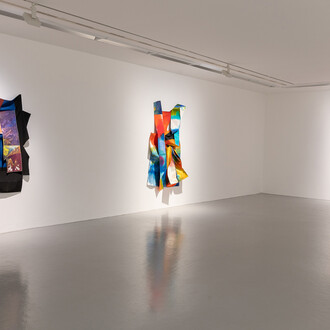Kerlin Gallery is pleased to present last day of May, an exhibition of drawings by Merlin James, Stephen McKenna and Elizabeth Magill, three celebrated painters for whom drawing represents a fundamental and vital creative practice. Spanning almost five decades of work, last day of May shows the breadth, diversity and importance of the medium, exploring its possibilities for direct expression, reflection, playfulness, and exploration.
Merlin James draws in bouts, returning to the medium periodically, but reflects that “it always feels like a release of energy”. His charcoal sketches of boats, trees and architectural forms are deceptively simple: executed with quick and concise strokes, they carry the immediacy and urgency of working en plein air. The humble structures he depicts appear isolated, remote – the dashed forms of a sailboat juddering on water; the swing of a windmill's eaves; paths sloping up to odd houses on hills. James also produces intimate drawings of the human body, rendered with an attentiveness and honesty that makes even explicit imagery feel tender. Rather than approaching drawing as a foundation for painting, he notes that, “Drawing is more of a stimulant and a first touch. It's an erotic thing.”
Though seldom exhibited, Elizabeth Magill’s drawings also form a primary component of her work. As in her paintings, images are spliced, fragmented and layered. Figures drawn from the history of painting (Manet’s Olympia, or Venetian master painting) sit alongside sketches of nature, studies from photographs or faces from pop cultural and philosophical history – Feargal Sharkey, or Bertrand Russell spawning the head of Keith Richards. As well as line, Magill uses drawing to experiment with colour, suffusing her images in mists of ochre, or splashing details in red. She describes the process of drawing as “mathematical”, and says that it “connects [her] with a kind of precision”. Often, she draws in the morning, as a way to connect with the day.
Though intricate, exacting, and classical in language, Stephen McKenna's drawings are subverted by an experimentation with scale and subject matter, and dashed through with a peculiar wit. In a study of three nude figures, for instance, ancient fertility figures teeter into contemporary abstract forms with curvilinear body shapes – the mythological, the archaeological and the contemporary co-existing in the same dreamspace. In a text written on his work in 2014, McKenna compared making marks on paper with “the exact movements of the actor or the dancer, the ritual performance of the priest, or the wild gyrations of the demagogue and the madman”. Though clearly concerned with the primacy and urgency of the medium, McKenna also wrote of its meditative potential, and positioned it as an antidote to media oversaturation. “In looking at a drawing, we are obliged to think about what we see in the drawing, and what it represents,” he wrote. “Perception and conception come together.”
By bringing together three artists who bend the medium of drawing in different directions, last day of May presents both possibilities outlined by McKenna: for deep thought and contemplation, but also for urgency and experimentation.















